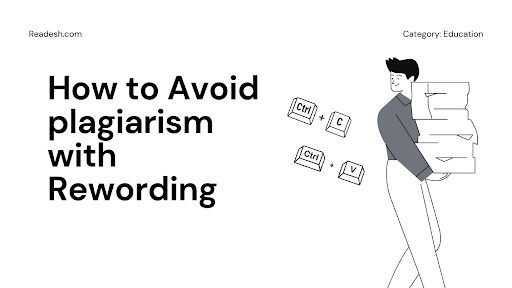Last Updated on October 11, 2022 by
For writers, bloggers, and content developers, churning out quality content is the main aim. However, creating plagiarism-free content can be tasking, challenging and time-consuming.
Content is intended to generate traffic and increase conversion rates. Unfortunately, when lazy writers plagiarize content, it affects the SEO ranking of their website, and visibility to their audience is limited.
So, to avoid plagiarism, you need to use reword techniques that will help you churn out clean and top-notch content.
Read on for more information about techniques to avoid plagiarism.
Table of Contents
What is plagiarism?
Plagiarism involves stealing another person’s idea and content without properly crediting the original owner. Sometimes, writers don’t intentionally steal people’s ideas and words, however, most are done intentionally.
Nevertheless, Google’s ever-advancing algorithm doesn’t care if it’s intentional or not. Once your content passes off as being copied, you are not going to rank properly. Also, when you write for a website and you’re caught using other people’s content, your work would be flagged.
What is rewording?
Rewording means using similar phrases, sentences, or lexicon to bypass plagiarism. Consider it as a smart strategy to create better and plagiarism-free content.
Rewording is common among graduate students, big media, and many bloggers. Once trendy news breaks out, some sources write faster than others. So, to stand out, you need to rewrite or in a better situation, reword.
There is several rewording software out there and most do not offer efficient rewording. However, when you reword at rewritetool.net, be rest assured of error-free and quality content
Amazingly, rewritetool.net is free. As a writer, you can’t afford to miss out. Rewritetool.net offers a free sentence rewriter generator that can be beneficial to writers when seeking to make exceptional content. Try it out today and you’ll be amazed at how efficient it is.
How to Avoid Plagiarism
Moving on, let’s check out some reword techniques you can use to bypass plagiarism in your content:
Summarizing sentences
You can reword content by simply summarizing the sentence. Writers can’t simply take a look at some relevant sources and do a summary of all information.
This will make it difficult for any algorithm to be able to pinpoint a specific word. A summary is good because it gives the reader an idea of what you are trying to convey without writing it word for word.
Use Synonyms
You can reword content to avoid plagiarism by using closely related words. You can get thesaurus and dictionaries to help you get some synonyms which can help you bypass synonyms.
Changing lots of words will make your content different and unique. However, be careful to look at the context when using synonyms, don’t take it out of context.
Changing word forms
Another technique of rewording content to avoid plagiarism is using new word forms. You will need to understand some basic structure in grammar, especially verbs.
You will need to use past, present, and continuous tense. It’s expected that you are smart when changing word forms so that your content will come out naturally.
Change the sentence structure
Many times, people find it difficult to paraphrase words from the source. You can reword such content by changing how the sentence is structured. While many of the original words are the same, when you change the structure of the word, it becomes different.
A good example is:
Original sentence: “The boy quickly ran across the finish line, seizing yet another victory”.
This can be reworded as: “The quick boy seized yet another victory when he ran across the finish line”.
On a final note;
Plagiarism is most detested by Google and writers try to avoid it as much as possible. However, when you get stuck and can’t write 100% unique content, rewritetool.net has got you covered.
In conclusion, use the above-mentioned reword techniques when trying to avoid plagiarism of your work. They are tested and trusted!
Read more interesting articles at Readesh



























